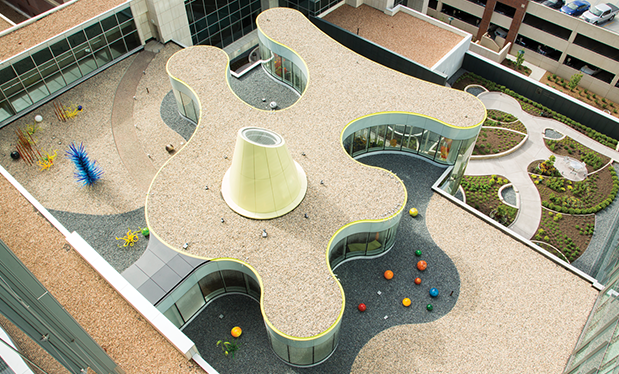According to the Environmental Protection Agency, more than 8 million tons of roofing waste are generated in the U.S. every year, with a majority going directly to landfills. As landfill tipping fees continue to rise, roofing contractors and building owners are recognizing the benefits of restoring or recycling what they previously sent to landfills. And now that most major cities require mandatory landfill diversion of construction waste, including roofing waste, design teams and corporate accounts increasingly are selecting roof membranes, as well as other building materials, based on maximizing life span and recyclability at the end of a product's service life.
Roof system restoration and recycling conserves embodied energy in manufactured products, creates a variety of jobs, and can reduce expenses of material purchase and disposal.
Diverting roofing tear-off materials from landfills can drastically reduce municipal waste loads, considering commercial roofing covers vast square footages. The 2012 International Green Construction Code supports recycling roofing waste, especially through construction and demolition language, in Section 503.1: Construction Waste Management; Section 504: Waste Management and Recycling; and Section 505.2.3: Recyclable Building Materials and Building Components. In addition, green building rating systems such as LEED,® Living Building Challenge and Green Globes have various guidelines for designing buildings with long-lasting products and diverting waste from landfills, touching on all stages of the roofing life cycle.
In 2015, the U.S. Conference of Mayors adopted a resolution in support of Municipal Zero Waste Principles, placing waste reduction and diversion at the top of their Hierarchy of Materials Management. Many major urban areas already mandate 50 to 90 percent landfill diversion through restoration, reuse, recycling and sometimes incineration for energy-from-waste. Some cities include reduced tipping fees or other incentives for landfill diversion, or increased fees for dumping recyclable items with restrictions on what can be dumped.
Recycling candidates
For roof systems, recycling and reuse are most feasible for loose-laid or mechanically fastened single-ply membranes, as well as metal roof systems and components. PVC can be recycled into commercial-grade flooring and concrete expansion joints, roof walkpads and pavers. EPDM can be made into a variety of products and usually is the easiest of the commercial membranes to recycle. Nonshingle asphalt can be restored under certain conditions. There already is a healthy infrastructure for recycling residential shingle roofing, and commercial options are catching up.
Most whole, dry, uncontaminated insulation is reusable or recyclable. Insulation is considered contaminated when it is saturated with water or inseparable from other materials, such as adhesives or fasteners. Asphalt-based membranes that cannot be restored may be incinerated to create electricity at facilities throughout North America. However, the membranes are heavy to transport, so this usually only makes sense when a local facility is available.
There is some encouraging research underway by Pacific Northwest National Laboratory and mycologist Paul Stamets regarding composting hard-to-recycle byproducts of oil refining (like asphalt) using the digestive processes of mushroom composting. Certain fungi, such as oyster mushrooms, can break down many of the environmentally toxic components of oil byproducts in a matter of weeks, at minimal cost. It is the responsibility of building material manufacturers to support this research and help solve the huge waste problem created by their products. The U.S. Conference of Mayors agrees and has listed extending producer responsibility as first in its Hierarchy of Materials Management.
Zero waste
The trend toward zero waste is advancing at breakneck speed as large corporations and governments recognize the unnecessary time and expense associated with the dump-and-replace cycle. Even where it is less economically feasible to recycle, the demand is rising from customers for companies to demonstrate sustainability measures, and waste management often is the easiest starting point.
For instance, Wal-Mart has a zero-waste goal and currently is diverting more than 80 percent waste from landfills for all its U.S. facilities. DuPont's residential and commercial construction products manufacturing processes went from dumping 81 million pounds of waste annually to zero waste in three years.
The U.S. Army's Net Zero Waste program already diverts more than 65 percent of its generated waste. Target is nearing its goal of zero waste for all its roofing projects. Boeing, Honda, Subaru, Toyota and many other large companies have similar initiatives.
In addition, most colleges, universities and school districts have zero-waste goals, though plenty are unaware roofs can be recycled and that doing so may eclipse years of bottle, can and paper recycling volume from within the buildings. Greater education, reaching all stakeholders, can help the roofing industry guide these end-of-use conversations.
Zero waste also means no wasted space and maximizing the use of valuable real estate. Underutilized rooftop space happens to be the best spot on a building for harvesting energy, growing food and adding amenity space when properly designed to accommodate such use.
For instance, hospitals increasingly are using their rooftops for healing gardens. Schools in dense urban areas transform their roofs into outdoor classrooms. And developers of condos and high-rises recognize how much more residents are willing to pay to have sunny garden access away from the concrete jungle.
Extended life cycles
Of all options for landfill diversion, the most economically and environmentally responsible solution is to extend roof systems' service lives for as long as possible, maximizing embodied energy and resources. Recycling is better than dumping, but it still costs money and has its own carbon footprint; keeping products in use and functioning as intended should be the first goal. In roofing, maximizing embodied resources involves important decisions at every step. Product selection, design and installation are only half the story; beyond that, it comes down to maintenance.
Most roofing professionals know maintenance can add years of service life to roof systems and is necessary to help avoid premature failure. Properly caring for a membrane per manufacturer's instructions is significantly less expensive than reactive repairs and can keep from voiding the warranty. Maintenance usually includes simple visual inspections of the flashing, seams and drains, removal of debris, and making any necessary repairs before leaks happen.
Restoration
When a roof system is at diminishing returns with maintenance and repair, the next step (before planning an expensive reroof) is to consider the possibility of restoration. Each scenario is different, but many roof systems that might otherwise be torn-off can be restored and their service lives extended. For example, Beachwood, Ohio-based Tremco® Roofing's research and development lab has shown restoration can extend membrane life up to 30 warranty years from the point it is restored, not from when it is installed.
The low-hanging fruit for restoration is hot- and cold-applied built-up roofing, polymer-modified bitumen and adhered single-ply membranes. And one of the most sustainable systems is metal roofing. According to "The relative durability of low-slope roofing," in Proceedings of the Fourth International Symposium on Roofing Technology, metal roofs that are properly designed, installed and maintained have some of the longest service lives when restored and are mostly recyclable when it is time to retire them.
Roof systems that have irrevocable design errors, low-quality or deteriorating materials, or large areas of soaked insulation are not good restoration candidates.
Restoration starts with visual and laboratory evaluations such as testing for membrane tensile strength and insulation R-value. Flashings usually are replaced or extensively restored, and seams are reinforced before priming and resurfacing with products compatible with the existing system type and condition.
Beyond restoration, there are other ways to significantly extend a roof system's service life. Many roofing manufacturers and experts agree that when a roof is fully covered with aggregate ballast, pavers or a vegetative roof system, it can significantly extend the membrane life span.
According to research from Reed College in Portland, Ore., adding a vegetative roof to a building increases the sale and lease value of commercial building space by 5 percent or more. These buildings fill faster, and tenants stay longer.
Vegetative roof systems also can manage stormwater and reduce the urban heat island effect while conserving energy in a building. Building energy conservation is not only measured by thermal transfer through the roof, which may be minimal on a well-insulated roof regardless of whether it is covered in vegetation. Green roofs contribute to building energy conservation because they can be significantly cooler than exposed roofing materials on a hot day because of the evaporative effect of plants and soil. This also can reduce the workload of rooftop HVAC systems.
Recycling
If a roof cannot be feasibly restored, the next step is to identify a recycling partner. There are several national companies, and many major metropolitan areas have private or municipal recyclers for single-ply membranes and metal.
Every recycler has its own guidelines, but generally the recycling company will provide trucks and drivers and haul material away after the tear-off crew fills the trucks. The cost of the trucks and haul usually is set below the cost of dumping to remain competitive. For some types of insulation such as extruded polystyrene, recyclers often charge nothing or might even pay for the boards because the resale value is so high.
Considerations must be made to prepare materials for recycling. For single-ply membranes, this usually involves sweeping the membrane; cutting out seams, patches and fasteners; and rolling or folding the membrane to be hauled away. For crews inexperienced with roof recycling, this process can take longer than expected the first few times, so be sure to budget accordingly. Each crew and job site is different, but a good rule of thumb is to add an extra hour per crew per day for recycling and more for the first project or in challenging staging scenarios.
One more option
For roofs that cannot be reasonably restored or recycled, there is one more option before disposal, which is harnessing energy from waste. Candidates for this approach are asphalt-based products, fully adhered single-ply, contaminated insulation and coated membranes. Cutting seams and separating is not necessary for turning waste into energy, but materials need to be small enough to fit into a burner, which generally is 3 feet by 3 feet by 3 feet, or made into rolls no more than 3 feet wide and 2 feet thick. Covanta Environmental Solutions, Milwaukee, is the biggest energy-from-waste provider with facilities all over North America and intake processes specifically designed for roofing.
A better way
The design and construction industries are moving toward longer-lasting products and alternatives to the expensive and destructive dump-and-replace cycle. Specific to commercial roofing, there are countless ways to extend the life of a roof system throughout the entire process. Resource management is the responsibility of everyone involved starting with the manufacturer and extending throughout design, installation, maintenance and tear-off, with municipal support. Offering better solutions can improve market identity and allow access to more projects for everyone involved—and happens to be good for our environment.
Elizabeth Hart is executive director of Green Roof info Think-tank, Portland, Ore.
Terminology
It is easy to stumble over the litany of terms surrounding "green" infrastructure and construction, so here is a quick primer:
Zero waste is the redesign of resource life cycles so all products are reused, with nature as a model. It is the ability to avoid sending any excess material resources to a landfill or other nonreclamation waste center.
Waste or landfill diversion is zero waste in action. It generally refers to the prevention or minimization of generated waste through source reduction (such as restoration of roofing), as well as recycling, reuse and composting.
Energy-from-waste, also called waste-to-energy, involves the incineration of garbage to provide electricity. There are arguments for and against this type of energy production. As in dumping, raw materials are forever lost, but dumping also creates significant pollution with nothing gained, whereas one roofing tear-off could create electricity for many households.
Tips
When readying roofing materials for recycling, consider the following:
- Prepare the membrane for recycling as it comes off of the roof, not after. Attempts to tear it off and then later cut and fold it generally will double the amount of time and labor, and more than likely the membrane will end up being dumped anyway.
- It is a lot harder to add recycling into a project at the last minute, so include the topic in the conversation from the beginning. Start planning early, and make sure the costs are included in the bid.
- Other recyclable roofing items to consider include aggregate or ballast, pavers and any metal components. Unpainted wood usually can be recycled as well. Scraps from a new roof can be thrown in with recycled tear-off materials if they are of the same type.
- Stone ballast is exceedingly heavy and should be reused locally to minimize haul expense and emissions. It can be used at nearby construction projects (such as for infill), on other roofing projects or given to landscape companies.



